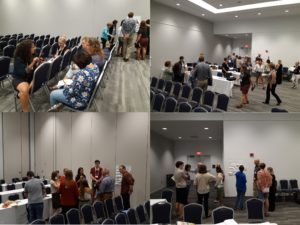 I take a student-focused approach in my teaching; encouraging students to directly engage with course concepts and test their hypotheses. By reading the latest education research, assessing student learning, and listening to student feedback, I adapt my courses from year to year to empower a diversity of students and provide an inclusive atmosphere for learning.
I take a student-focused approach in my teaching; encouraging students to directly engage with course concepts and test their hypotheses. By reading the latest education research, assessing student learning, and listening to student feedback, I adapt my courses from year to year to empower a diversity of students and provide an inclusive atmosphere for learning.
My teaching style involves a host of different strategies in the classroom and the outdoor “classroom.” This includes incorporating backward design, peer learning, exercises in quantitative skills, inquiry-based learning, flipped classrooms, and student-scientist interactions into my courses.
Backward Design
 I have embraced the Backward Design framework for developing courses and have led workshops about pedagogy and backward design at UC Santa Barbara, Michigan State University, and several Ecological Society of America annual meetings. It is an easily understandable framework that provides scaffolding and transparency to ease instructor efforts and allay student anxieties.
I have embraced the Backward Design framework for developing courses and have led workshops about pedagogy and backward design at UC Santa Barbara, Michigan State University, and several Ecological Society of America annual meetings. It is an easily understandable framework that provides scaffolding and transparency to ease instructor efforts and allay student anxieties.
Peer Learning
Peer learning in classroom has been shown to have a number of benefits for students including increased learning outcomes, a sense of community, and leveraging a diversity of ideas. In all of my courses I have implemented peer learning to some extent, whether it’s course-long group work or think-pair-share in the classroom setting. At Michigan State University we have used CATME to form teams based on student provided information. As this program is now proprietary, I am currently in the process of developing a Shiny/R open source version to help instructors form effective groups in large courses.
Exercises in developing quantitative skills

In line with Vision and Change recommendations, I emphasize scientific practices in my courses. In particular, I focus on quantitative skills such as data collection, management, analysis, and visualization. These skills are highly transferable and cut across STEM fields. In my introductory biology course at Michigan State University, myself and colleagues developed a course-long module to collect and analyze tree phenology data from different species of trees on campus. This lesson has since been published in CourseSource.
Inquiry-based learning
Each of my lectures are organized by questions, not topics. These questions are posed in the beginning and I have the students answer them at the end of lecture, thus sandwiching their education with a question and their own answer to said question. I highly encourage students to ask their own questions of the material and attempt to answer them on their own. The crux of my Plant Ecology course is a research proposal whereby students propose an ecological question of their own design. This lesson has been published in the EcoED Digital Library run by the Ecological Society of America.
Flipped classrooms
Before implementing a flipped  classroom, I participated in flipped learning workshops and read the literature on best-practices. For my plant ecology course, I produced Scientific Study Videos (SSVs). They are 5-8 minute clips that highlight an important study in plant ecology and complement lecture material. Understanding HOW scientists learned what we know today is an incredibly valuable thought exercise for students as they learn about the natural world around them. What’s printed in textbooks came from an inquisitive scientist at some time. Students today can be just as inquisitive as those who came before them. Link to Youtube Playlist of Scientific Study Videos
classroom, I participated in flipped learning workshops and read the literature on best-practices. For my plant ecology course, I produced Scientific Study Videos (SSVs). They are 5-8 minute clips that highlight an important study in plant ecology and complement lecture material. Understanding HOW scientists learned what we know today is an incredibly valuable thought exercise for students as they learn about the natural world around them. What’s printed in textbooks came from an inquisitive scientist at some time. Students today can be just as inquisitive as those who came before them. Link to Youtube Playlist of Scientific Study Videos
Student-scientist interactions
I feel very strongly about increasing representation in the classroom. Under-represented groups (URGs) drop out of STEM for a number of reasons, most notably is that they do not feel like they are part of a community. In my courses I attempt to engage students directly with a diversity of scientists to help students form a scientific identity. Myself and collaborators developed “Scientific Mini-chats” where we Skype in a scientist who works on the topic we are covering. Students can ask questions and get to know the person behind the science. I purposely target scientists from URGs to show that scientists come from a variety of backgrounds, just like the students. We are in the process of writing up this exercise for publication.
Courses I have taught as instructor of record
Introductory biology (x2), “General Plant Ecology” (x3), “Ecology and Management of California Wildlands” (field-based course)
Courses I have taught as a TA
Introductory biology (x4), “Foundations of Ecosystem Restoration” (x3), “Ecology and Management of California Wildlands”, “Introduction to Ecology”